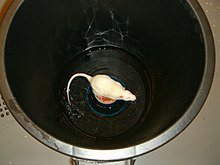Flowerpot technique

The flowerpot technique is used in sleep deprivation studies. It is designed to allow NREM sleep but prevent REM sleep. A laboratory rat is placed on top of an upside down flowerpot which is placed in a bucket of water. While in NREM sleep, the rat retains muscle tone, so it can sleep on top of the flowerpot. When the rat enters REM sleep, it will lose muscle tone and fall off the flowerpot into the water, then climb back up and re-enter NREM sleep.
See also
References
This article includes a list of references, related reading, or external links, but its sources remain unclear because it lacks inline citations. (March 2015) |
- Porkka-Heiskanen, T.; Tuornisto, L.; Yilnen, M.; Stenberg D. The effect of REM sleep deprivation on histamine concentration in different brain areas. Live Sciences 54 (2): 1720–25, 1994.
- Sayan, H.; Gelir, E.; Babul, A. Brain Stem and Cerebral Cortex Histamine Concentrations in the Rem Sleep Deprived Rats, Turk. J. Med. Sci., 31 (2001) 499–502 [1]
- Rosenthal, Martha S. Physiology and neurochemistry of sleep, American Journal of Pharmaceutical Education, Summer 1998. [2]
